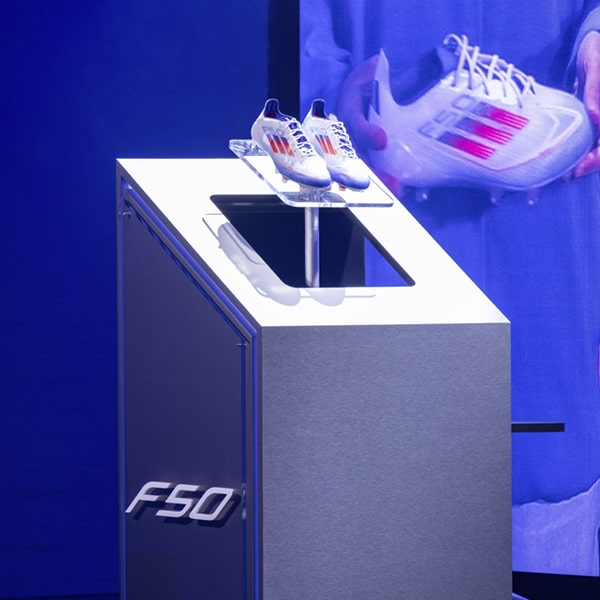SoccerBible Access - Inside adidas Herzogenaurach

SoccerBible was granted exclusive access to not just the home of adidas football, but to the home of adidas! Herzogenaurach is the birthplace of some of sports most glorious and memorable moments, and as an iconic statue of Adi Dassler looks out over the on-campus running track and football pitch, you realise the impact adidas have made on football and sport in general.
Bringing you never-before-seen access, SoccerBible was invited where few have ventured before. As the doors to the adidas Group Headquarters in Herzogenaurach opened, the pioneering world of adidas was exposed. Take a look and share your thoughts with the SoccerBible community online.


With ultra modern buildings and an uber-cool campus, the home of adidas was all that we expected, an acknowledgement of the past and heritage but with an outlook clearly on the future. Having been at the heart of some game changing moments in football, stretching back from the 1954 World Cup to the modern day Predator and F50 adizero, for SoccerBible and fans of football it almost felt like a pilgrimage to one of the birthplaces of the modern game.


Based in Bavaria Germany, Herzogenaurach houses only 25,000 people but is home to some of football's most creative minds. For over half a century, Herzogenaurach has been striving to provide every athlete with the best possible equipment, the result of which has been sport-defining moments captured and celebrated within the walls of the adidas Group HQ.


As you move into the entrance building you are greeted by the biggest campaign in the brands history; adidas is all in. Showcasing their presence across and into different sports, cultures and lifestyles, so whatever the game you put your all into it. You emerge out the otherside onto a campus of modern styling equipped with a variety of sporting venues.


Walking past a variety of football, tennis and basketball courts you're then greeted by a mysterious black-out building with no visible entrance or signs to suggest what's contained within. But once inside we learn that not only does this building house a collection of equipment from sports most historical moments, but is also the venue where new products are first unveiled.


A collection of sports finest moments and the equipment used, detail the history of adidas. Starting from August 18th, 1949, when Adi Dassler first registered adidas in the commercial register in FÜrth (near Herzogenaurach). The official name of the company back then was Adolf Dassler adidas Sportschuhfabrik . And first used in 1949, the 3-Stripes that have gone on to become one of the most famous symbols in football and sport.


Still referred to as the Miracle of Bern, the 1954 World Cup was where adidas' story of innovation within football began. Facing the unbeatable Hungarians in the final, victory for Germany seemed impossible. Enter Adi.


A close friend of team coach Sepp Herberger, Adi Dassler provided the players with a whole new boot made out of thinner, lighter leather and with screw-in studs. While the Hungarians struggled during the rainy final wearing heavy rain-soaked boots with studs too short to find a grip on the muddy field, the German team went on to score the game-deciding goal with more grip and a better feel for the ball.


For Germany, the victory brought new confidence to a post-war nation, for adidas and Adi Dassler the innovative football boots brought international recognition and a market leadership in the football business. And contained within a glass case, is one of the football boots worn by Fritz Walter, captain of the 1954 World Cup winning West Germany side.


Adi Dassler extended his company s portfolio in 1963 when he developed the first adidas football. Called Santiago, it was made up of 18 leather panels and used as a back-up ball for the 1966 World Cup in England. However, it wouldn t take long until the first official World Cup ball called Telstar was produced in 1970.


adidas started developing high-performance match balls in 1963, when most balls were heavy, brown and painful to kick. Like all other balls in its time, the adidas Telstar was completely made of leather; however, unlike any other ball it featured 32 hand-stitched panels, creating the roundest sphere of its time. The revolutionary design of Telstar wrote football history: it was the first white football ever to be decorated with black pentagons, and as Mexico 1970 was the first live televised World Cup, the name derives from Star of Television as the ball was far more visible on black and white television.


But if you want to become adidas best-selling football boot, you need to be a little bit special and completely revolutionise the game. The Predator, first introduced for the 1994 World Cup in the US, featured rippled fins which gave players more control, more power and more swerve on the ball. In combination with the new Traxion technology on the outsole, the Predator was the biggest revolution in football boot design since the 1954 football boot.


Worn by such modern greats as David Beckham, Zinedine Zidane, Kaka and Raul, the adidas has gone on to become one of the most iconic and successful boot ranges which is now in its 11th incarnation. In celebration of this and the Pred wearers, the corridor housing the collection of adidas' great football moments and historical equipment, features impressions in the ground of some of the famous wearers.


Next-up on the exclusive tour was access to the latest addition to the adidas campus - the innovation centre - the building from which the future products are currently in the design process. Unfortunately, and not surprisingly, in this modern white building there were no cameras allowed. Because for what was on show we're talking the next few years of football products, all currently in development, but what we can say is that adidas have got some ambitious plans!


The final leg of our tour was to visit the Adi Dassler Sportplatz, a venue that has played host to the likes of Real Madrid and more recently AC Milan, and from where the latest products are play-tested. All under the watchful gave of the man who started it all: Adi Dassler, with boot in-hand in that most famous and iconic image.

They've certainly been at the heart of some of football's most historical moments, and from what we've seen, adidas are focused on continuing to deliver the best possible equipment for their athletes. The adidas headquarters are a true reflection of a brand inspired by their history, and being driven by innovation!
Stay tuned as SoccerBible continues to bring you exclusive access into the world of football. SoccerBible gets you into the areas football fans dream of, so become a part of the soccer gear society and enjoy the experience. Share your opinions with us online!







